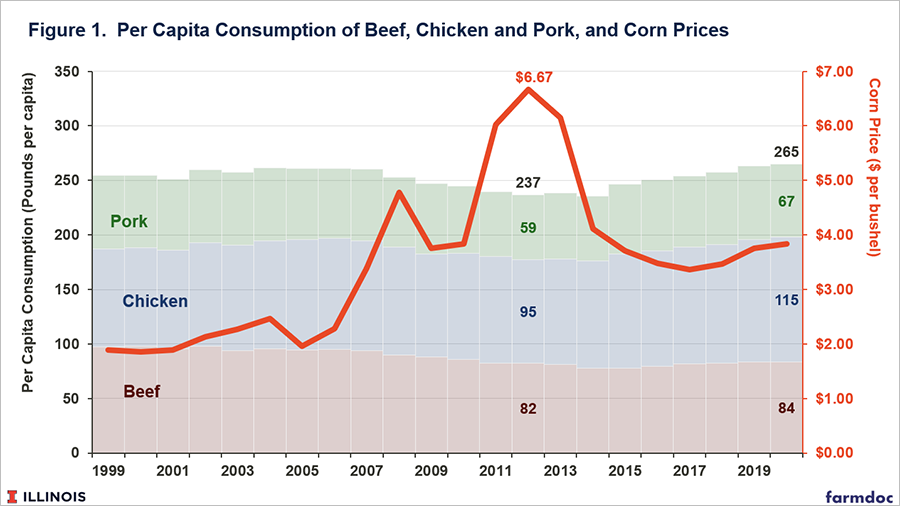Us State Consumes the Most Beef
Livestock feed is a significant use of both corn and soybeans. Forty percent of the domestic corn crop and over 60% of domestic soybean production are used as livestock feed (April 2021 USDA WASDE). Animal agriculture is obviously important to the demand for corn and soybeans, with meat consumption being the major product of animal agriculture. Herein, we detail the per capita consumption of meats in the U.S. Focus on meat consumption is warranted given the recent climate, ethical, and health considerations facing the meat industry. The potential impacts of these evolving factors are difficult to quantify and will most certainly fluctuate in importance and influence. Still, examining past patterns can provide benchmarks and expectations for meat demand and livestock feed use over the next decade.
Current Consumption
Figure 1 shows per capita consumption of meat in the U.S. from 1999 to 2020. Over the entire period, meat consumption averaged 252 pounds per person. There were, however, trends in the data. Per capita consumption was relatively stable from 1999 to 2006. From 1999 to 2006, meat consumption averaged over 250 pounds per person. Then, meat consumption fell from 2007 to 2013, reaching a low of 235 pounds per person in 2014. From 2015 to 2019, per capita consumption increased each year, reaching 264 pounds per person in 2020.

Two items contributed to the decline in per capita consumption in the period from 2007 through 2016. First, ethanol production began its build in 2006 to 2013. Increasing use of corn in ethanol generally led to higher corn and soybeans prices. Also contributing to price increases were low corn yields in 2010 through 2012. Figure 1 contains a line giving yearly corn prices during this period, illustrating the relationship between higher prices and per capita consumption. Over the 1999 to 2019 time period, per capita consumption and corn prices had a -.74 correlation coefficient.
Second, there was the Great Recession of 2008, which caused lower disposable incomes. Reductions in incomes typically lead to lower meat consumption.
Shifts in Consumption
There has been a switch in consumption across the three major meat categories. In 1999, beef had more consumption than chicken or pork. Over the time period, beef consumption declined from 97 pounds per capita in 1999 to 83 pounds in 2020. Pork consumption has remained relatively stable, equally 68 pounds per capita in 1999 and 67 pounds per capita in 2019. Chicken consumption increased from 89 pounds per person in 1999 to 112 pounds per person in 2019. Chicken now has higher per capita meat consumption over beef and pork.
Shifts in per capita meat consumption will have noticeable impacts on feed use. Compared to a broiler feed conversion ratio of around 2-to-1, commercially produced beef cattle typically convert feed at a ratio of 6-to-1. Assuming that consumers will continue to replace beef with chicken in their diets, the amount of feed input used per pound of meat consumed will decrease.
Implications
Overall, U.S. consumption of meat is relatively stable, temporally influenced by the economics of feeding livestock and general economic conditions. Economic growth in the U.S. could increase meat consumption marginally, but large increases should not be expected. As a result, domestic meat consumption likely will not be a driver of increased corn and soybean consumption. If anything, feed demands for domestic consumption will likely decline with a continued switch to chicken consumption. Increases in livestock feeding efficiency will further reduce demand.
Yields of corn and soybeans likely will continue to increase in the future. Given that per capita consumption of meat will not grow, increased demand will have to count on exports and other uses. Exports of meats could be a growing use of corn and soybeans.
Disclaimer: We request all readers, electronic media and others follow our citation guidelines when re-posting articles from farmdoc daily. Guidelines are available here. The farmdoc daily website falls under University of Illinois copyright and intellectual property rights. For a detailed statement, please see the University of Illinois Copyright Information and Policies here.
Source: https://farmdocdaily.illinois.edu/2021/05/an-overview-of-meat-consumption-in-the-united-states.html